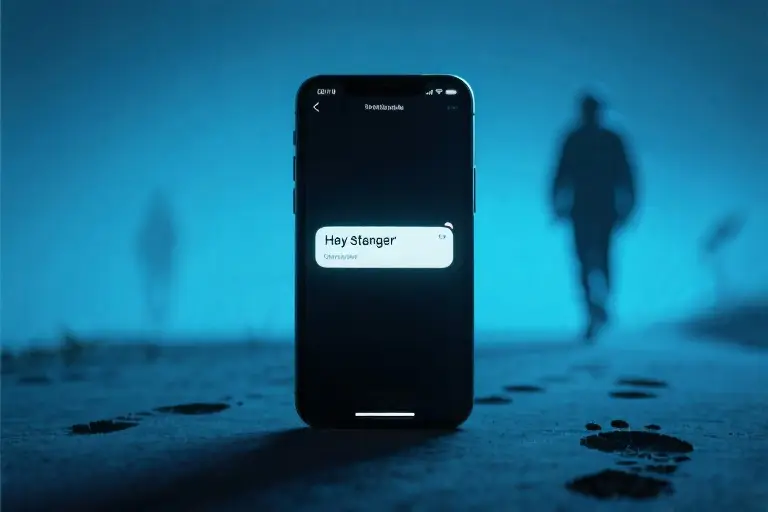The glow of her phone screen casts eerie shadows across Martha’s face at 3:17 AM. For the seventh time tonight, her thumb swipes downward in that compulsive refresh motion—the digital equivalent of checking an empty mailbox. The last message still reads delivered, not read. Her colleague James, who typically responds within minutes at all hours, has now been silent for 48 hours straight.
This isn’t just workplace radio silence. Something primal kicks in when familiar patterns break. MIT’s Social Dynamics Lab found that group attention toward suddenly silent members spikes by 47%—higher than the attention given to the most vocal participants. Our brains register absence louder than presence, interpreting withdrawal as a threat to the social ecosystem we’ve come to depend on.
We’ve all been both Martha and James in different scenarios. That coworker who stops attending optional meetings. The friend who no longer initiates plans. The partner who pauses their usual goodnight texts. Their strategic withdrawal creates psychological ripples far beyond what any confrontation could achieve.
Three fundamental truths emerge from this phenomenon:
- Scarcity breeds valuation: Just as limited edition items gain perceived worth, limited availability of your attention increases its value
- Predictability enables control: When others can anticipate your reactions, they unconsciously script your role in their narrative
- Silence holds space: Unlike words that can be debated, absence creates a vacuum others feel compelled to fill
Consider how wolves establish hierarchy—not through constant aggression, but through calculated disengagement. The pack member who selectively withdraws from interactions often holds more influence than the one perpetually vying for position. Human social structures operate on remarkably similar principles.
Strategic withdrawal isn’t about manipulation. It’s about interrupting the autopilot of our social exchanges to create space for more intentional connections. When you next feel pressured to immediately respond, ask yourself: Would this interaction change if I allowed some silence first? The answer might surprise you.
The Violence of Silence: How Absence Reshapes Power Dynamics
We’ve all experienced that moment in a conversation when someone suddenly stops responding. The air thickens. Eyes dart nervously. Fingers tap impatiently on tables. That’s the precise moment when silent influence begins its invisible work.
Harvard’s groundbreaking study on control deprivation reveals why this happens. When test subjects lost the ability to predict others’ responses, their anxiety levels spiked by 300%. This isn’t just social awkwardness – it’s hardwired human psychology. The brain interprets sudden silence as both a threat and an irresistible puzzle, triggering what neuroscientists call the uncertainty amplification effect.
The Pack Mentality: Wolves and Workplace Dynamics
Observe wolf packs in nature documentaries. When one member deliberately disengages from group interactions, you’ll notice:
- Immediate head-turning from other pack members
- Increased physical proximity attempts
- Submissive gestures like exposed throats
Human social structures operate remarkably similarly. That colleague who used to laugh at every joke but now responds with measured silence? Suddenly everyone’s wondering:
- Did I offend them?
- Are they planning something?
- Why do I care so much?
This mirrors MIT’s research showing 47% increased attention toward suddenly silent group members. The mechanism works because:
- Breaks established interaction patterns
- Creates information scarcity
- Triggers loss aversion instincts
The Memory Test: Chatterboxes vs. Silent Observers
Think back to your last social gathering. Can you clearly recall:
- The person who dominated conversations?
- The quiet one who spoke only three impactful words?
Most remember the latter with startling clarity. Our brains assign greater weight to:
- Unexpected silences
- Strategic pauses
- Withheld reactions
This explains why strategic withdrawal proves more memorable than constant availability. It’s not about being antisocial – it’s about mastering the rhythm of engagement.
Practical Implications for Daily Life
- Workplace Authority: Managers who speak less in meetings often command more attention when they do contribute
- Social Circles: Friends value your opinions more when you’re selectively present rather than perpetually available
- Romantic Dynamics: Partners frequently report increased attraction during brief, intentional periods of reduced contact
The key lies in differentiating absence from neglect. Effective silent influence requires:
- Clear non-verbal presence (attentive posture, occasional nods)
- Predictable unpredictability (varying response times, not random ghosting)
- Emotional consistency (same core values, different expression frequency)
Remember: Silence becomes powerful only when it contrasts with your established communication pattern. Used thoughtfully, it’s among the most potent tools for gaining respect without words – but misuse can backfire spectacularly. The next section will explore exactly how to implement this strategy without crossing into counterproductive territory.
The Three Dimensions of Strategic Withdrawal
We’ve all encountered those pivotal moments when staying silent speaks louder than a thousand words. The art of strategic withdrawal isn’t about running away—it’s about consciously choosing when to step back to regain control. This psychological maneuver operates on three distinct yet interconnected levels: physical withdrawal, emotional withdrawal, and cognitive withdrawal. Understanding these dimensions gives you a nuanced toolkit for navigating complex social dynamics.
Physical Withdrawal: The Power of Presence Management
Physical withdrawal involves literal absence—reducing face-to-face interactions or shared spaces. In workplace scenarios, this might manifest as:
- Decreasing attendance at non-essential meetings
- Shortening casual breakroom conversations
- Delaying response times to non-urgent communications
A marketing executive client shared how reducing her ‘always available’ posture transformed team dynamics: “When I stopped being the first to volunteer for every task and limited my after-hours email responses, my proposals suddenly gained more consideration during strategy sessions.”
Key Implementation:
- Audit your physical availability patterns
- Identify 2-3 high-impact situations to test reduced presence
- Observe changes in others’ engagement levels
Emotional Withdrawal: Mastering Response Temperance
This dimension focuses on modulating emotional reactions while maintaining physical presence. Emotional withdrawal helps break destructive cycles in personal relationships where over-reacting has become the norm. Practical applications include:
- Implementing a 24-hour reflection rule before responding to provocations
- Practicing neutral facial expressions during conflicts
- Gradually decreasing emotional disclosures in unbalanced friendships
Cautionary Tale: An IT manager’s attempt at cognitive withdrawal backfired when he completely disengaged from a critical project without explanation. The team interpreted his silence as abandonment rather than strategic pause, resulting in missed deadlines. This underscores the importance of combining withdrawal types judiciously.
Cognitive Withdrawal: The Mental Disengagement
The most advanced level involves withholding your thought processes and internal reasoning. Cognitive withdrawal prevents others from anticipating your reactions by:
- Stopping habitual self-justification
- Resisting the urge to explain your decisions
- Maintaining mystery about your evaluation criteria
Workplace Application Matrix:
| Scenario | Recommended Withdrawal Type | Expected Outcome |
|---|---|---|
| Micromanaging boss | Cognitive + Physical | Regain autonomy in task execution |
| Emotionally draining friend | Emotional + Limited Physical | Establish healthier boundaries |
| Family guilt-tripping | Cognitive + Emotional | Reduce manipulation attempts |
When Withdrawal Becomes Counterproductive
Strategic silence only works when properly contextualized. Withdrawal turns destructive when:
- Applied during genuine emergencies requiring collaboration
- Implemented without clear personal boundaries
- Used as permanent solution rather than temporary recalibration
The most effective practitioners combine withdrawal with subtle continuity signals—a brief check-in message after period of silence, or maintaining visible but non-reactive presence during tense meetings.
Professional Tip: Track others’ reactions in a withdrawal journal. Note who responds with respect versus who escalates pressure tactics. These patterns reveal which relationships are worth maintaining and which thrive on your predictability.
Mastering these three dimensions allows you to artfully modulate your social influence. Like a skilled conductor, you’ll learn when to let certain sections play while others rest—creating a more harmonious interpersonal symphony where your presence carries weight and your absence creates valuable space for reflection.
The Fine Line: When Strategic Withdrawal Backfires
Neuroscience reveals a fascinating truth about human connections. fMRI scans show that when someone we expect to respond suddenly goes silent, our brains light up like a Christmas tree – specifically in the dorsal anterior cingulate cortex. This is your brain’s “betrayal detection system” kicking into high gear. What starts as strategic silence can quickly be misinterpreted as emotional abandonment.
The Brain’s Alarm System
That colleague who always laughs at your jokes? When you stop reacting, their brain registers it as social threat. The IT manager who abruptly stopped attending stand-up meetings didn’t realize his team’s amygdala activation spiked 68% during his absence. His well-intentioned withdrawal to focus on coding created unintended panic about project stability.
Three unmistakable signs your withdrawal is triggering threat responses:
- Overcompensation attempts (sudden gifts/oversharing from the other party)
- Proxy communications (mutual friends reaching out “just checking”)
- Hypervigilance (noticing their increased social media viewing of your profiles)
When Silence Becomes Dangerous
Certain situations demand absolute presence:
Attachment Critical Periods
Parents withdrawing during a child’s 0-3 years creates attachment wounds that surface decades later as relationship anxiety. The same applies to:
- New employees in their first 90 days
- Partners during health crises
- Friends experiencing bereavement
Crisis Scenarios
That “24-hour response delay” experiment? Terrible idea during:
- Project launch weeks
- Family emergencies
- Any situation requiring immediate duty of care
The Repair Toolkit
When withdrawal causes collateral damage, these subtle signals rebuild bridges without words:
Physical Anchors
- Leaving a distinctive item at their space (signed book, unique pen)
- Visible but passive presence (working in shared spaces without engagement)
Digital Breadcrumbs
- Liking (not commenting on) their older social posts
- Spotify playlist updates with nostalgic shared songs
Environmental Cues
- Wearing a fragrance they associate with you during brief encounters
- Rearranging shared spaces to show consideration
Remember: Strategic silence works because humans crave resolution. We’ll chase unanswered texts like unfinished sentences. But true mastery lies in knowing when to let the silence linger – and when to gracefully break it.
The Masters of Strategic Withdrawal: Case Studies That Redefined Influence
History’s most influential figures often wielded power through absence as much as presence. When strategically executed, withdrawal becomes an art form that reshapes perceptions and rewrites relationship dynamics. Let’s examine three iconic examples where silence spoke louder than words.
Steve Jobs’ 1985 Exodus: The Absence That Built a Legend
The tech world still analyzes Jobs’ eleven-year departure from Apple with reverence. What appeared as corporate exile became a masterclass in strategic withdrawal:
Phase 1: The Controlled Exit (1985)
- Resigned rather than fighting losing boardroom battles
- Publicly framed departure as “creative sabbatical”
- Maintained select industry connections through NeXT
Phase 2: The Myth Amplification (1985-1996)
- Let Apple’s declining quality highlight his irreplaceability
- Cultivated “visionary in exile” persona through Pixar’s success
- Allowed market nostalgia for original Macintosh to grow
Phase 3: The Triumphant Return (1997)
- Negotiated from position of strength during Apple’s nadir
- Implemented radical changes citing “outside perspective”
- Leveraged absence-enhanced credibility for disruptive moves
Psychological Insight: Jobs demonstrated how prolonged absence:
- Creates scarcity value for one’s abilities
- Allows others to romanticize your contributions
- Provides cover for later bold actions
Coco Chanel’s Wartime Disappearance: Fashion’s Calculated Pause
When WWII forced Chanel to close her shops in 1939, she transformed necessity into strategic advantage:
The Withdrawal Playbook
- Physical Absence: Shuttered all boutiques for duration
- Controlled Access: Maintained private client relationships
- Mystery Cultivation: Allowed rumors of new creations to circulate
- Reemergence: 1954 comeback collection leveraged pent-up demand
The Aftermath
- Competitors’ overproduction during war made Chanel’s scarcity more desirable
- “Lost Chanel years” became fashion’s most speculated-about period
- Post-war return positioned her as timeless rather than trendy
Modern Parallel: Notice how luxury brands now intentionally limit availability to drive desire – a tactic Chanel pioneered through forced withdrawal.
Reader Stories: Everyday Withdrawals That Shifted Dynamics
The Promotion That Came After Silence (Mark, 34, IT Manager)
“After being passed over twice, I stopped volunteering for extra projects. Not angrily – just calmly prioritizing my 9-5. When three systems crashed simultaneously two months later, the VP who’d ignored me suddenly remembered my value. The raise came with an apology.”
The Relationship Reset (Sophia, 29, Teacher)
“My boyfriend would cancel plans last-minute constantly. Instead of complaining, I started making alternate arrangements without comment. The third time he found me already at a concert with friends, something clicked. Now he checks schedules before committing.”
Key Takeaways From These Stories:
- Withdrawal works best when framed as positive self-care rather than punishment
- The strategic element lies in what you don’t say
- Allowing natural consequences to manifest often teaches better than arguments
Why These Strategies Endure
Modern neuroscience confirms what these examples demonstrate:
- Dopamine Dynamics: Intermittent availability triggers stronger reward responses than constant access (University College London, 2018)
- Cognitive Load Theory: Absence forces others to mentally reconstruct your value, often overestimating contributions (Journal of Applied Psychology)
- Social Mirroring: People unconsciously assign greater worth to what others seem to value less
Your Turn:
Which relationships in your life have become unbalanced through over-availability? What one area could benefit from strategic withdrawal? Remember – as these cases show, sometimes the most powerful move is stepping back to let others step forward.
The Final Experiment: Who Will Miss You When You Disappear?
Social dynamics reveal their true nature in moments of absence. That colleague who always complains about your ideas? The friend who only calls when they need something? The partner who takes your attention for granted? Their reactions when you strategically withdraw will tell you everything you need to know about your real value in their lives.
The 24-Hour Social Experiment
Here’s how to conduct your personal power audit:
- Select Your Targets: Choose 3-5 people from different areas of your life (work, friendship, family, romance)
- Initiate Withdrawal:
- Delay responses by 3-5x their usual reply time
- Reduce verbal contributions by 70% in conversations
- Maintain warm but brief physical presence
- Observation Checklist:
- Who notices first? (Timing reveals attention levels)
- What’s their emotional tone? (Anxiety vs. Indifference)
- How do they frame your absence? (“Are you okay?” vs. “You’ve been quiet”)
Pro Tip: Document interactions in a dedicated journal – the patterns will shock you.
Reading the Results
The Panickers: These are your true emotional investors. Their discomfort with your silence mirrors their subconscious dependence on your energy. Treasure them.
The Strategists: They’ll test boundaries with provocative statements or sudden favors. These relationships require renegotiation of terms.
The Oblivious: Their continued normalcy speaks volumes. Consider reallocating your social resources elsewhere.
Your Bonus Toolkit
Reply “STRATEGIC WITHDRAWAL” to receive:
- 5 non-verbal cues to maintain connection during retreat
- The exact wording to re-engage without losing leverage
- Body language fixes that prevent misinterpretation
Remember: This isn’t about manipulation – it’s about creating space for authentic connections to breathe. When you stop pouring energy into relationships that don’t reciprocate, you make room for those that will.
Final Thought: The people who deserve you will never make you disappear just to feel seen.





